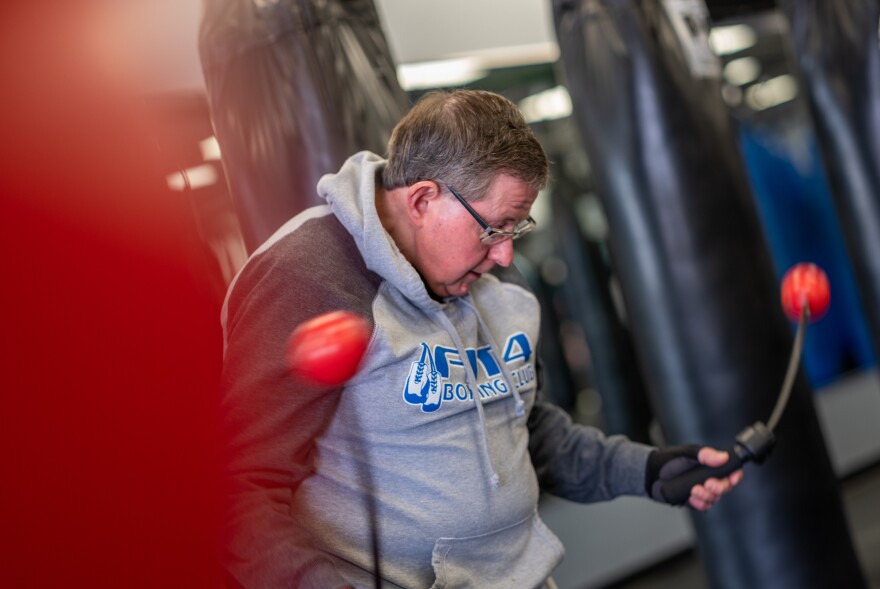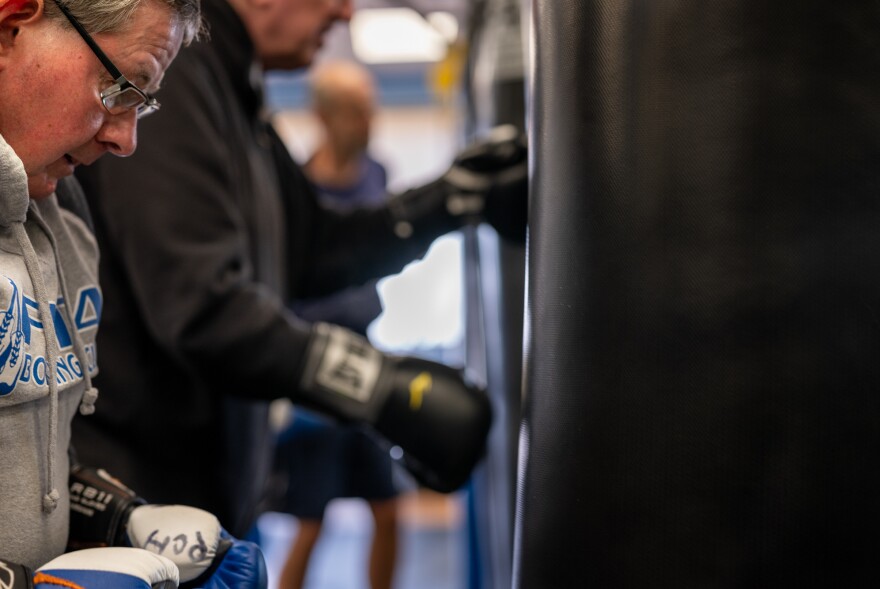Paul knew his young grandson was in danger.
"Out of the corner of my eye I could see this little figure moving," he says. The figure was heading for a steep flight of stairs.
But what could he do? Paul was sitting down. And after more than a decade of living with Parkinson's disease, getting out of a chair had become a long and arduous process.
But not on this day.
"Paul jumped up from the chair and ran to my grandson," says his wife, Rose. (The couple asked to be identified by only their first names to protect their medical privacy.) "I mean, he just got up like there was nothing and ran to pick up Max."
Amazing. But it's also the kind of story that's become familiar to Peter Strick, professor and chair of neurobiology at the University of Pittsburgh and scientific director of the University of Pittsburgh Brain Institute.
"It was a great example of what people call paradoxical kinesia," Strick says. "It was a description of just what we are studying."
Paradoxical kinesia refers to the sudden ability of a person with Parkinson's to move quickly and fluidly, the way they did before the disease eroded a brain area involved in movement.

The phenomenon is a variation of the placebo effect. But instead of being induced by the belief that a sugar pill is really medicine, it tends to appear in situations that involve stress or a strong emotion.
For Paul, "it was the fear of his grandson falling down the stairs," says Strick, who learned about the event in an email from Rose.
A treatment that's "all in your head"
Strick believes the placebo effect deserves more respect than it often gets.
"I love it when people say it's all in your head, because your brain is in your head," he says. "There are real biological underpinnings for these kinds of things."
So Strick has assembled a team of prominent scientists to find the biological underpinnings of paradoxical kinesia. The team hopes what they learn will lead to new treatments for Parkinson's disease, which affects nearly 1 million people in the U.S.

The effort involves several labs at the University of Pittsburgh and one at the University of California, Santa Barbara. It's being funded by a $12 million grant from the Aligning Science Across Parkinson's Initiative and implemented by the Michael J. Fox Foundation.
Strick's collaborators plan to focus on two circuits in the brain that appear to control voluntary movement. One is damaged by Parkinson's, leading to symptoms including tremor, freezing, and poor balance and coordination.
"Our hypothesis is that there's another circuit that's intact, and that this circuit isn't affected in Parkinson's disease," Strick says.
Strick's team believes this other circuit can be switched on by strong emotions, including positive ones.
"It's engaged by our sense of reward, by the joy of doing something," he says.
One patient benefited from riding a bicycle
For at least one Parkinson's patient, Strick says, that appears to include the joy of riding a bike.
Strick is fascinated by a video made by Dutch neurologists in 2010.
It begins with a man who has severe Parkinson's struggling to walk down a hospital corridor. He's hunched over, shuffling his feet. His hands are trembling. Then it shows the same man, minutes later, effortlessly riding a bike around the hospital parking lot.
Most of Strick's collaborators at the University of Pittsburgh have seen that video, says William Stauffer, a neurobiologist whose lab studies reward and emotion.
"What I find really incredible is that he's riding the bike and he comes back and he hops off the bike and he freezes," Stauffer says. "It's immediate. That's weird."
The team believes that for this man, riding the bike was like taking a placebo because it gave him joy. But when the man got off, the joy — and its benefits — disappeared almost instantly.
To Stauffer, this behavior is one more piece of evidence that people with Parkinson's still do have an intact movement circuit in the brain, a pathway that is only switched on in certain situations.
"If you can somehow isolate the pathway that enables that and turn it on," Stauffer says, it might offer a new approach to treating Parkinson's.
A monkey model was born from a drug gone bad
Parkinson's gradually kills or disables cells that make dopamine, a chemical messenger associated with both movement and feelings of pleasure, reward and joy.
The drug L-DOPA can replace dopamine. But its effect tends to wane over time and higher doses can produce side effects, like involuntary movements. Deep brain stimulation can also reduce symptoms such as tremor, but it requires surgery and carries risks.
So scientists have been searching for ways to improve treatments by studying monkeys, whose brains control movement much the way human brains do.
That research is possible because of something tragic that happened in Northern California, says Rob Turner, whose lab at the University of Pittsburgh studies the brain circuits that allow skillful movement.
In the early 1980s, people who were using a form of heroin began showing up at hospitals with symptoms that looked strikingly similar to Parkinson's.
"One of the local neurologists, Bill Langston, did the detective work and he discovered that someone had botched a batch of synthetic opioids and made a neurotoxin instead," Turner says.
This neurotoxin attacks the same brain cells involved in Parkinson's disease. A little toxin kills a few cells, a lot kills many more — making it possible to mimic the stages of Parkinson's. That discovery allowed scientists to learn a lot about how the disease damages a human brain, Turner says.
"The other thing about it is that it gave us the ability to produce a monkey model of Parkinson's remarkably similar to what we see in humans," he says.
So Turner's lab will use this monkey model to study how the placebo effect works. To do that, though, they'll need to induce enough joy in a monkey to switch on the brain circuit that restores normal movement.
The team is still thinking about how to do that. But Turner says just the prospect of getting a fruit juice reward makes a monkey happy. So how about the prospect of a really special treat, like a tropic smoothie?
"Not just the normal, small-size tropic smoothie," Turner says. "The monkey's going to get the 'yes, nice work!' kind of reward."
The prospect of a smoothie, of monkey joy, will act as the placebo in this experiment. With luck, it will cause a monkey's brain to switch on the circuit that temporarily allows normal movement.
But because this is occurring in a monkey, in the lab, scientists will be able to monitor what's happening in the animal's brain.
Helen Schwerdt, a bioengineer whose lab builds tools to measure brain activity, plans to place up to 100 tiny sensors in the brain of each animal long before they develop symptoms of Parkinson's. Those sensors will monitor levels of dopamine, the chemical messenger that's lacking in Parkinson's.
"This is the first time that we can actually look at these dopamine signals and see what happens over the course of months and even a year," Schwerdt says.
When a monkey anticipates getting a smoothie, the sensors should reveal a burst of dopamine signals coming from the brain circuit that controls movement.
If that happens, it would confirm Strick's hypothesis and provide a potential new target in the brain for Parkinson's treatments. The hope is that by using electrical stimulation or a drug aimed at this target, the team can not only switch on the circuit that allows movement, but keep it on.
Dancing and boxing seem to help Parkinson's patients
Any new treatment is obviously a long way off. In the meantime, doctors and patients have been trying other approaches that may use the placebo effect to help people with Parkinson's.

For example, dance classes seem to help patients move more quickly and smoothly. One reason may be that rhythmic activities help synchronize groups of brain cells involved in movement. Another may be that these classes simply make people happy.
Paul, the Parkinson's patient who moved so quickly to save his grandchild, has found another form of exercise that seems to help.
At the Fit 4 Boxing Club in suburban Pittsburgh, Paul is throwing punches at a pair of mitts worn by the gym's owner, Rich Mushinsky.

"One, two, one, three," Mushinsky calls. Paul delivers the punch or combination associated with each number. He looks fluid and quick and happy.
The boxing club is one of many gyms around the country that offer special classes for people with Parkinson's.
"Everything that a boxer does is everything that a Parkinson's patient is lacking," Mushinsky explains. And a boxing workout is designed to improve things like balance, coordination and speed.
The classes also give people living with Parkinson's a friendly place to meet others facing the same disease.
"It's not a cure, but it makes them better for a short period of time," Mushinsky says. "And the fighters will tell you how it makes them feel."

Paul says it makes him feel better. "It does help tremendously with movement," he says. "You're able to move quicker, like a cat, so to speak."
Presumably, a cat feeling something like joy.
Copyright 2023 NPR. To see more, visit https://www.npr.org.



